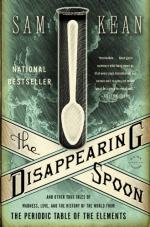|
This section contains 876 words (approx. 3 pages at 400 words per page) |

|
The Disappearing Spoon Summary & Study Guide Description
The Disappearing Spoon Summary & Study Guide includes comprehensive information and analysis to help you understand the book. This study guide contains the following sections:
This detailed literature summary also contains Topics for Discussion on The Disappearing Spoon by Sam Kean.
The following version of the book was used to create this study guide: Kean, Sam. The Disappearing Spoon: And Other True Tales of Madness, Love, and the History of the World from the Periodic Table of the Elements. Boston: Little, Brown and Company, 2010.
In The Disappearing Spoon, Sam Kean explores stories related to the elements of the periodic table in order to explore the history of our species and our place in the physical world.
In Part One, Kean writes about the organization of the periodic table and how it highlights the links between similar elements and element families. Major element groups include the noble gases, the halogens, the alkalis, the transition metals, and the lanthanides. Carbon is an important element as it is essential in the creation of amino acids and proteins, which means that it is essential for the existence of life as we know it. Silicon may possibly be the basis for other forms of life elsewhere in the universe, but on our planet, it plays a significant role in semiconductors and the like. In this section, Kean explores the development of the periodic table, which was largely introduced by a man named Dmitri Mendeleev, as well as the rivalry between theoretical and experimental science.
In Part Two, Kean writes about how elements are formed through either fusion in stars or the deaths of stars that create supernovas. The distribution, quantity, and placement of various elements on our planet can tell scientists a lot about the nature of the earth, how it was formed, and significant events in the planet's history, such as the mass extinction of dinosaurs. Kean then writes about the roles of various elements in chemical warfare, such as in the creation of poisonous gasses, machinery, and missiles, as well as how the demand for certain elements has led to warfare in places like the Democratic Republic of the Congo. The rest of Part Two focuses on the mid-twentieth century. In chapter 6, Kean writes about the Manhattan Project and the development of nuclear science that led to the creation of atomic bombs. Chapter 7 charts the scientific efforts to discover and name transuranic elements in the second half of the twentieth century, which led to rivalries between American and Soviet scientists.
Part Three is about increasing complexities in the periodic table. Kean writes about mistakes various scientists have made, such as dismissing the possibility of fission or insisting on an ultimately incorrect model of DNA. In Chapter 9, Kean writes about various dangerous elements on the periodic table, including several poisons. He also tells the story of David Hahn, an amateur scientist who attempted to build a nuclear reactor in his mother's shed in order to solve the world's energy crisis and dependence on fossil fuels. Chapter 10 is about the uses of elements in medicines and drugs. It explores the science of chirality which played a significant role in the development of modern drug synthesis. Chapter 11 is about how various elements interact in the body. Titanium, for example, is essential to the science of joint replacements, while iodine, which commonly appears in iodized salt, decreases birth defects.
The chapters in Part Four focus on politics, money, art, and madness respectively. Through the lives of Marie Curie, Lise Meitner, and Otto Hahn, Kean explores how personal politics can shape a scientist's career. Curie was derided for her salacious personal life, while Lise Meitner was denied the Nobel Prize when her long-time collaborator Otta Hahn neglected to speak up for her contributions to the work that won him the award. Metallic elements have a long history as currency and in the stories of various historical gold rushes. They have also played a role in art and luxury design. Furthermore, their use in drug treatments for mentally ill artists has raised questions about how pharmaceutical treatments may impact creative work. In Chapter 15, Kean writes about pathological science, in which a scientist is determined to prove his or her pet theory, despite the evidence to the contrary.
In Part Five, Kean writes about how elements behave in extremely cold temperatures and the type of chemistry that can be done in those conditions, including the creation of new types of matter. Chapter 17 is about the importance of bubbles in chemistry, whether that be in the discovery of a new element, such as radon, or in helping scientists to understand phenomena such as sonoluminescence. The penultimate chapter opens with a discussion of minute systems of measurement including atomic clocks. Kean then discusses the relationship between electrons and their nucleus. The measurement of this relationship is known as alpha and attempting to determine whether or not it is a fixed constant raises important questions about the nature of the universe and the life within it. Kean closes this chapter with a discussion of how elements such as magnesium can help in the search for life on other planets. The last chapter is about the future of the periodic table. It is likely that new elements will be discovered and also possible that new forms of matter will be created or discovered that will expand the periodic table. For now, Kean marvels at the simplicity of the current organization of the table and all the information it contains.
Read more from the Study Guide
|
This section contains 876 words (approx. 3 pages at 400 words per page) |

|



